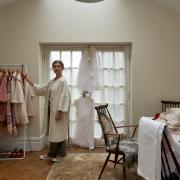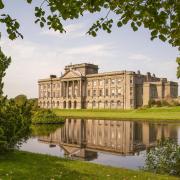A thousand years after his last visit to Knutsford, King Canute is back, in the form of a giant wood carving at the town's Heritage Centre.
The statute of the king of England, Denmark and Norway was unveiled by Agusta Thorarinsdottir, honorary consul of Denmark in Manchester, in front of guests, volunteers and members of the Vikings Re-enactment Society. Consul Agusta gave a speech talking about the long-standing association and friendship between the United Kingdom and Denmark.
Lord Ashbrook who opened the ceremony described King Canute as arguably one of the most famous individuals ever to have been associated with Knutsford. When the Danish King Cnut and his army first arrived on English shores in 1016 his passing through Knutsford was a short-lived affair. There wasn’t much for him to see – just an expanse of wasteland, a small settlement and perhaps one insignificant river to cross before continuing his march north.

Cnut reigned as King of England until his death in 1035 and is buried at Winchester Cathedral. Some years later, when William the Conqueror ordered the great survey of the lands, the Dane's visit to Knutsford was recalled, and the town was recorded in the Domesday Book of 1086 as Cunetesford (Canute's ford).
Volunteers at Knutsford Heritage Centre who decided the town should have a permanent tribute to the king who bestowed its name, commissioned the life-size wood sculpture from chainsaw artist Andy Burgess. An oak from Peover was donated by landowner and Tatton Estate estate manager Henry Brooks. Permission was granted from Winchester Cathedral, where Cnut’s remains are kept in a mortuary chest, to use the image of the statue, and Andy began his sculpture.
Heritage Centre manager Val Bryant said: ‘The history of Knutsford is not just what happened in the last war, or 100 or 500 years ago. The history of the naming of our town started with King Cnut’s arrival on our shores in 1016. It still resonates with a large number of people in Knutsford today.’
The Heritage Centre’s exhibition Vikings, King Canute runs until July 22 with storyboards and artefacts on display. The sculpture can be seen in the Centre’s courtyard garden. Entry is free.

Knutsford Heritage Centre was set up in 1988 through the Groundwork Trust and is a registered charity. Its aims are: 'To preserve, protect and promote the historic past of Knutsford for the benefit and enjoyment of residents and tourists.'
It is housed in a reconstructed 17th-century timber-framed building, which was originally a tinsmith’s shop, tucked away in an almost hidden courtyard behind the bustling streets of Knutsford. It provides an ideal introduction to the story of Knutsford, its famous people and events such as Elizabeth Gaskell, Sir Henry Royce, Richard Harding Watt, the Racecourse and the Royal May Day Festival.
The centre is the custodian of the Knutsford Millennium Tapestry, which took four years to complete and involved more than 3,000 people.
The exhibition gallery has artefacts and collections on display, including Knutsford’s first Royal May Queen’s dress and crown from 1887 and there are regular themed exhibitions.
knutsfordheritage.co.uk



























